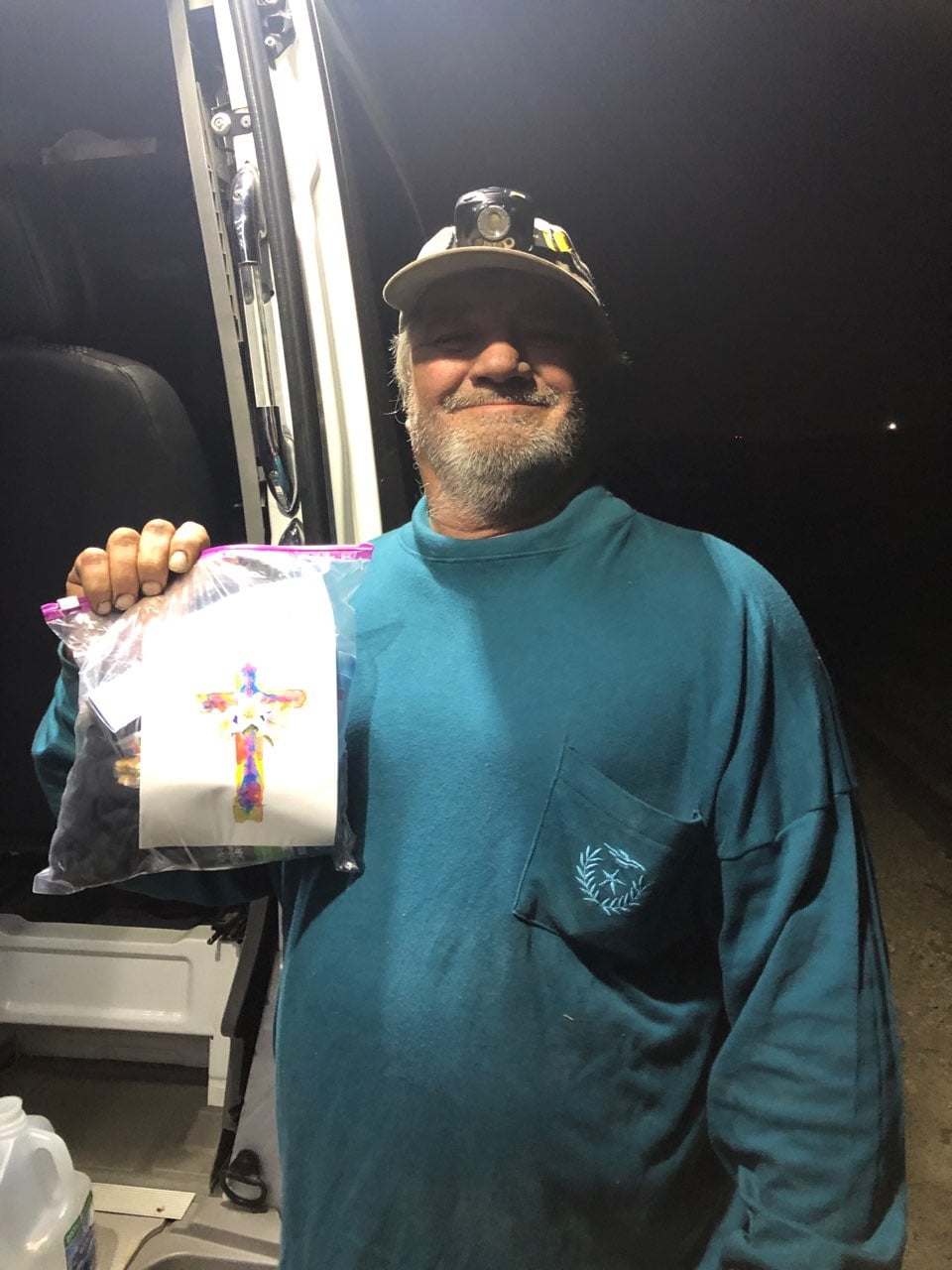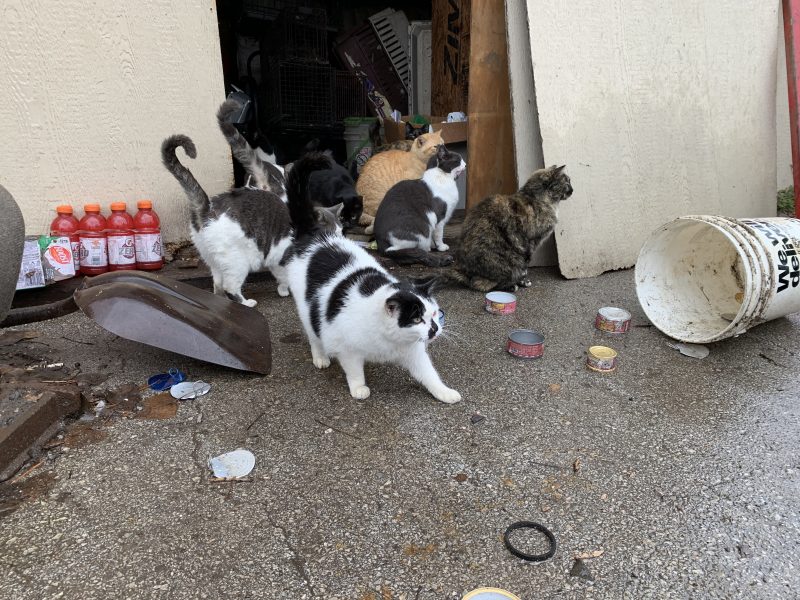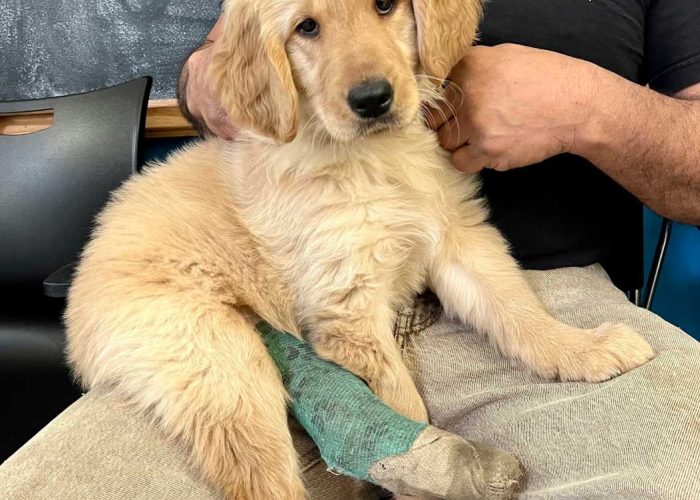We lost a client last week that we’d been working with for at least a decade. His name was Carl, and he was one of the best friends to cats that I’ve ever met.
Even so, the first thing I heard about Carl was that he wasn’t always easy to deal with.
I have to scroll all the way back to 2015 in my photos to find pics of my first meeting with him. I was new, and had no experience in the field to speak of. I wasn’t even doing communications work here yet; I was still the Pet Food Pantry Coordinator.
I went down to a lumberyard with my co-worker to deliver some cat food and ended up amazed at what I found, even though I’d been prepared for it. I’d never seen so many cats in one place, all looking so healthy and strong. At least a couple of dozen. I made a few friends that day, including a cat I started referring to as Peanut Butter Face.
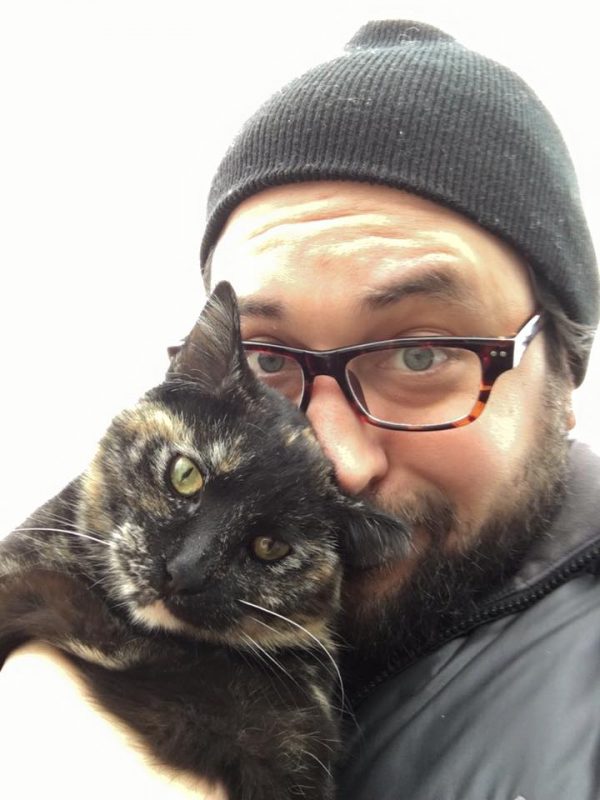
As for Carl himself, he seemed kind of remote. I got the sense that people weren’t his strong suit. But he clearly cared for these cats. It was the type of thing I recognized in myself; pets are sometimes just better company, especially if you’re a loner. The noise of other people is sometimes too much.
Carl was a Vietnam veteran who ended up homeless. He made friends with some guys in a lumberyard, and they agreed to let him stay on the property if he acted as a sort of makeshift security/caretaker. They helped him build a little shed at the edge of the property, and Carl’s life with cats began.
Lumberyards are perfect places for cats, because they tend to harbor mice. The cats hang around because of the mice, and eventually mate and make more cats. And more. And more. They also fight and yowl and spray. And that’s where TNR (Trap, Neuter, Return) comes in. You can’t make the cats go away. They’re often too feral to be adopted out to a regular home, so you trap them, get them fixed and return them to the place you found them. No more mating, and without the desire to mate, all those other behaviors are curbed as well. No more fighting, which means less chance of them spreading disease as well. It’s the only humane way of dealing with feral cats.
Ramona, our Community Field Coordinator, actually learned about TNR because of Carl. Our then Outreach Manager brought in a few cats in traps when she’d just come on board and started working the front desk. Being curious, Ramona asked what was going on, and he explained what TNR was and how all these cats came from the same place. Not too long after, Ramona dipped her toes in the TNR waters, and found that she had a real passion for it.
About a year later she moved on over to the outreach department, and she took over working with Carl.
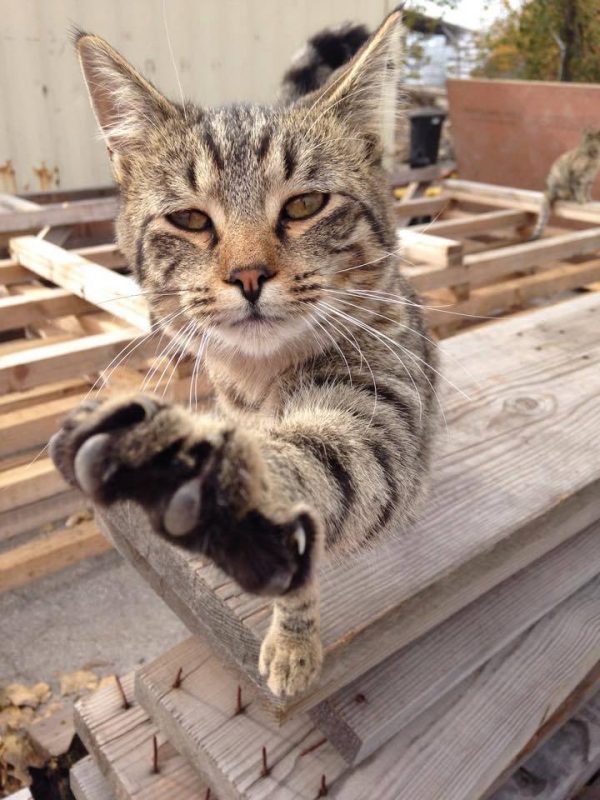
“Carl was a very brutally honest person who wasn’t always easy to get along with,” Ramona said when I spoke to her about him. “He was hard to get to know but once you did, he kind of developed a soft spot in your heart because you knew that he absolutely needed the help with his cats, and that his cats meant everything to him.”
When I chatted with Ramona the other day for this story, we were discussing the idea that we hold dear here at PRCKC, that even if the person you’re working with is a little difficult, you remember the pet or pets. You focus on helping the animal.
“You also need to meet people where they are,” I said.
“Exactly,” Ramona said.
And that’s what we did with Carl.
“So I knew what I was getting myself into,” she said, “so I was ready for it, but how can you ever be ready for someone like Carl? He was more of a guy’s guy, so we had to build a relationship. We had to learn to trust each other, and we did.
“And I’m not gonna lie and say we didn’t have our quarrels. He would call me, and if he couldn’t get ahold of me then he would call PRCKC and he would ask to talk to Amanda or Michelle because he knew their names, and even you, Dave, probably at one point, because he couldn’t get ahold of me.”
When he would get ahold of Ramona, he’d always say, “It’s Carl, down on the lumber yard,” as though she wouldn’t remember. How could anyone forget Carl?
He scrapped metal to buy cat food at the grocery store for his cats. If he was running low on food he would reach out to us, or to Uplift, or to Angel Hearts, or to the Humane Society. He knew where he could get help, but generally preferred to feed them himself if he could. If he found a new cat that needed fixing, he’d reach out to us right away.
“He was a right now kind of guy,” Ramona said.
So Ramona would bring him traps, and he’d trap the cats, then we’d come pick them up.
How many cats does she think we fixed for him over the years?
“You know I’ve thought about this over and over,” she said, “and the number 200 just keeps popping into my head, but you know I bet it could even be more than that. Because Marlan did it before me and I’ve worked at PRC for nine years. So we have to have been TNRing his cats for at least 10 years, and I know there were years where I did 20 or 30, so you do the math.”
Let’s say 200. That’s 200 cats that were fixed and vaccinated. That’s 200 cats that didn’t contribute to the feral cat problem we have in our community. That’s one guy. One guy did that. Because he cared.
We helped, of course. We were able to use grant funding and individual contributions earmarked for TNR to make things happen. And Carl was always grateful. But we were grateful, too.

But now he’s gone. Without giving details, it was an illness. We were devastated. All of us. Uplift, who helped him personally, and Angel Hearts and the Humane Society and us, of course, who helped with his cats.
Then almost immediately came the questions: what do we do now? What happens to his cats?
So Ramona and I went down to the lumberyard to take stock of everything on a dreary, gray, rainy afternoon. And we found a lot of cats, of course. So many cats.
It was weird to be there and not see Carl, just the evidence of his life. The lumberyard is going to tear down the shed because they’ve now hired a security company and don’t need another caretaker. So the shelter for these cats will be gone soon.
It turns out Carl had a good friend. His name is Roger. You don’t expect someone like Carl to have a good friend; he seemed to really want to keep to himself. Nevertheless, here he was. He found Carl’s VA card and has been in touch with them. He’s trying to get them to give him a military funeral, because he was a veteran and he deserves it. His life was undeniably shaped by his experiences in Vietnam, and he deserves some honor in death. He and the coroner are also trying to find any next of kin to let them know.
And we’re honoring him by trying to figure out this situation. The cats are friendly. So many friendly ones. There are the true ferals, too, that won’t be tamed, but so many of them are tame and sweet. Those are the ones we worry about the most.
As we’re checking out the situation, a man who works at the yard comes by to talk to us.
“There’s more than this,” he says, gesturing to the ever growing mass of cats starting to rub against our legs, looking to be friendly to someone even on this gray, rainy day. He tells us about the friendlier ones and points them out. He says that there’s a black cat that used to follow Carl around everywhere.
When he tells us that the black cat’s still wandering from place to place in the yard, looking for Carl days after his death, my heart breaks and I have to turn away for a moment.
Roger’s been feeding the cats but leaving the cans, so the ground is littered with empty cat food cans. We clear things away a little bit and then pour a bunch of dry cat food into a couple of trays on the ground, and feeding time begins. They crowd around, and even more cats come out when they hear the sound of the food being poured.
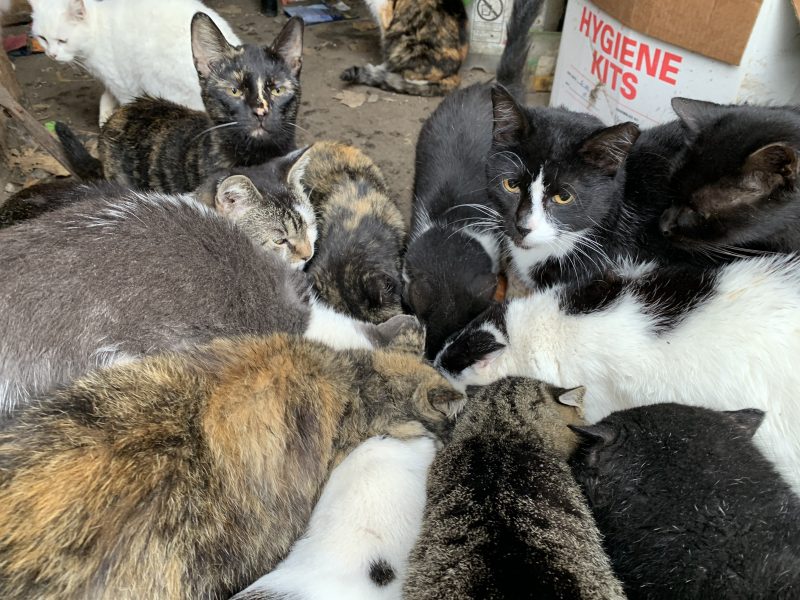
These cats are Carl’s legacy. We need to do right by them to do right by him. But what does that mean?
There’s another colony across the railroad tracks, we understand. Without a human food source, the ferals will figure things out, hunting for mice, maybe roaming to another colony. The lumber yard doesn’t want anyone feeding them anymore, in part because nobody’s going to be as dedicated to their care as Carl was, and in part because they don’t ever want there to be a problem with the security company that’s now patrolling the yard.
I look at the cats huddled around the bowls, so closely they might be telling each other secrets. I see many telltale ear tips that ferals are given after they’re fixed and think about how much Carl did for these cats. There are a couple of unfixed ferals that we’re going to trap. And we’re going to take the friendlies and get them in… somewhere. Shelters are overwhelmed right now, so it’s not going to be easy.
But we have to. Helping pets is what we do. And it’s what Carl would have wanted.
